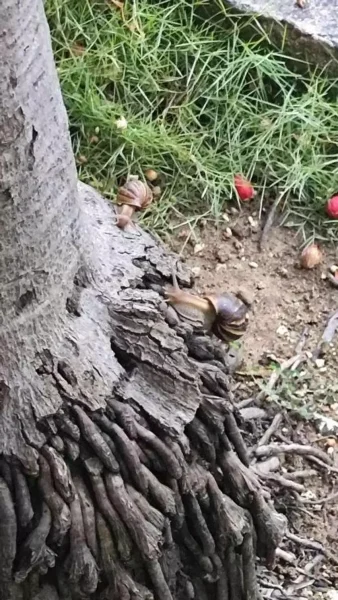The Stench of Garbage Spreads throughout Havana
and African snails also proliferate

“I just moved here and still notice it, but I’m horrified that we could so easily normalize this situation for the sake of survival.”
By Juan Diego Rodríguez (14ymedio)
HAVANA TIMES – Mayelín moved to the Diez de Octubre municipality a week ago, and now that she passes by Luyanó Avenue daily, she says all the residents live in a kind of “olfactory numbness.” According to the 28-year-old woman, there are more garbage dumps along the road than she can count, some even in a “wild” state, with small vermin and ecosystems. Living among the waste is already difficult, she says, but with the smell they give off, “it’s impossible to breathe.”
As she walks down the avenue, Mayelín recounts, “a river of sewage flows out from a broken pipe and, on its way, picks up all the liquids from food, dirt, and rotting garbage dumps. The smell is unbearable, and it even makes my stomach churn, but I’ve noticed that it only bothers me.” With little time living in Luyanó, the young woman has noticed that her neighbors, although they complain about the garbage and other problems, do not seem to care about the stench from the dumps.
“I think that constantly living among garbage, with no truck ever coming to collect it or a cleared drain for the water to go, has forced them to adapt. I, who just moved here, still notice it, but I’m horrified by the idea that we could so easily normalize this situation for the sake of survival,” she laments.
In Barrientos, as the area around the sports complex in the neighborhood is known, a huge garbage dump stretches for several meters —both horizontally and vertically— at the corner of Pedro Pernas and Manuel Pruna streets. In the part of the street not covered by waste, stagnant water prevents pedestrians from passing.
“Every morning when I take the dog out for a walk, I have to circle around the foul-smelling mass to cross the street,” says Yunior, a resident of the area. According to the young man, the dump, one of the largest in Luyanó, has begun to attract its own fauna. Cockroaches, flies, mosquitoes, and the occasional rat that can be seen are not the only tenants. “African snails have also started to appear. Wherever there’s a little bit of earth and grass, you find one,” he says.
The invasive species, which years ago was featured in public health announcements on Cuban Television due to its danger to human life, has begun to run rampant across the Island. “Now that they are everywhere and there are no resources to kill them, they’ve stopped talking about them, as if they suddenly became harmless. It’s obvious they’re doing it to avoid causing alarm,” reflects Yunior.
“The level of bugs that the dump attracts is such that my dog, who likes to hunt flies, goes crazy chasing them. The scene is amusing, but when you think about where all that filth comes from that you have to live with, you lose the desire to laugh,” he explains.

While it’s true that the less visible neighborhoods suffer the worst of the garbage epidemic because they are far from the eyes of foreigners and officials, it’s also a fact that, in the current state of the capital, not even the privileged areas are spared. A video recently published by Martí Noticias showed the fountain at the Hotel Nacional, one of the city’s most emblematic sites, right in front of the Malecón, where diplomats and guests of the regime often go. The footage showed stagnant, smelly water covered in a green crust of moss and garbage.
The same happens with Havana Bay, which is covered with cans, plastic cups and bags when a storm stirs the waters.
The direct responsibility for this situation falls on Communal Services, but the truth is that the company, without the necessary resources, doesn’t know how to deal with the garbage accumulating across the Island. A nearly pitiful example is Las Tunas, where authorities have been trying for months to fight against the waste, first by hiring private horse drawn or push carts and then, when that measure failed, by promoting volunteer work every Saturday.
This last proposal, as expected, also failed, and now the province is trying to get the state’s recycling company to step in. The “Reciclo mi Barrio” (I Recycle My Neighborhood) plan, published this Tuesday in Periódico 26, suggests that the company collect waste “door to door”—in reality, collection points have been set up in various neighborhoods— of the waste donated or sold by the population. The official press praised the initiative, which, in addition to the capital city, will begin in eight other municipalities.
Although the authorities claim that the initiative aimed at reducing the amount of waste going to the dumps “is here to stay,” we will have to see how long a plan that depends on the regime’s Achilles’ heel: fuel, will last.






This is the fastest way to slow down tourists from coming. For a country that cares about people health this should not be happening. Too many other places are now a better option than Cuba with the lack of food electricity and shortage of transport because of fuel shortages.
With stagnant water and waste comes disease. I hope something is done, this is extremely dangerous for the citizens.
What a sight for foreign tourists.
Is it the stench of the garbage, or that of the Poder Popular which is most offensive? Both reflect the administration of Dictator Diaz-Canel Bermudez and his cohorts. Incompetence reigns supreme! Change is not considered, thanks may be offered to Fidel and Raul Castro Ruz.